As countless exhibitions, books and conferences like to remind us, for the first time in our history, more people are living in cities rather than outside of them. Cities have grown and tried to adjust. New suburbs have emerged, new condos have risen, public transport has expanded, etc. The adjustments don’t always go smoothly. Cities have always been messy and complex. What is new though is that the physical infrastructures of a city have started to be overcome by invisible, intangible systems. Information technologies have infiltrated urban life and altered the way people experience it.
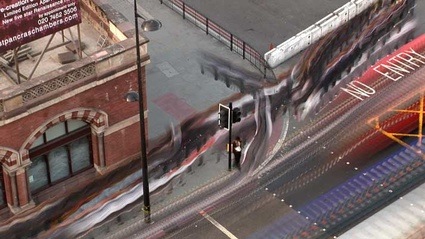 Semiconductor, Time Out of Place
Semiconductor, Time Out of Place
The practice of today’s architects and experts in urbanism must therefore reach beyond bricks and mortar. Their disciplines involves representations and maps of intangible dynamics such as traffic, air quality, noise levels, stress factor or mobile phone flows.
The exhibition HABITAR (to live in, to inhabit), which opened a few days ago at LABoral Art and Industrial Creation Centre in Gijón (SP), shows how architects, information architects, artists, designers and sociologists are exploring emerging scenarios in the city. Together they come up with a series of potential tools, solutions and languages to negotiate everyday life in the new urban situation.
The video Wireless in the World 2 by Timo Arnall embodies some of the issues raised by HABITAR. s Touch project is making visible the spatial properties of invisible wireless technology, in order to better understand and communicate with and about them.
Timo Arnall, Wireless in the World 2
The approach of HABITAR is rather wide. From Philippe Rahm’s fascinating meteorological architectures to the now cannonical projects of the MIT SENSEable City Lab, from Semiconductor‘s visualization of the rhythm of pedestrian traffic in the Kings Cross area in London to Mark Shepard’s cunning Sentient City Survival Kit, from the first completely self-sufficient solar house in Barcelona devised and built by IaaC-Instituto de Arquitectura Avanzada de Cataluña to Citilab-Cornellà’s UrbanLabs.
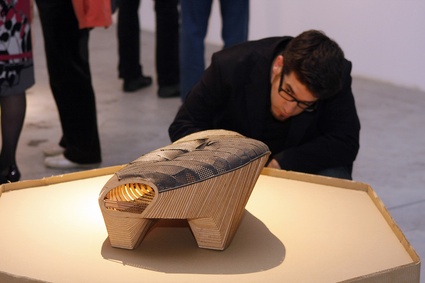 IaaC – Instituto de Arquitectura Avanzada de Cataluña, Fab Lab Solar House. Image courtesy Laboral
IaaC – Instituto de Arquitectura Avanzada de Cataluña, Fab Lab Solar House. Image courtesy Laboral
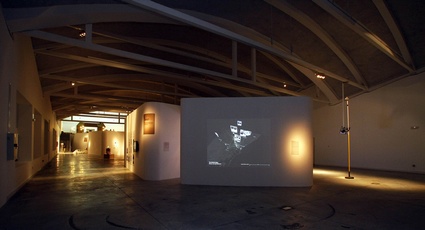 SENSEable City Lab (Carlo Ratti, Assaf Bidermann, Fabien Girardin, David Lu, Andrea Vaccari), Los ojos del mundo. Image courtesy Laboral
SENSEable City Lab (Carlo Ratti, Assaf Bidermann, Fabien Girardin, David Lu, Andrea Vaccari), Los ojos del mundo. Image courtesy Laboral
I’ll invite you to download the exhibition’s catalogue to get a better idea of the scope covered by HABITAR. Let me just highlight a couple of projects:
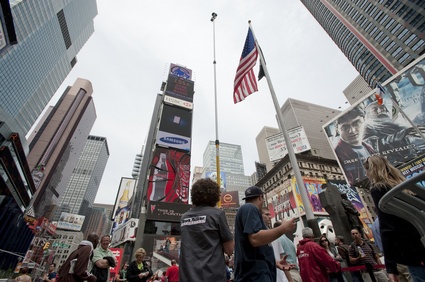 Near Future Laboratory, Penn Station Still Observation, 2009
Near Future Laboratory, Penn Station Still Observation, 2009
An Apparatus for Capturing Other Points of View, by Julian Bleecker + Rhys Newman, Chris Woebken, Markus Bleecker of the Near Future Laboratory takes its cues from The Social Life of Small Urban Spaces, a book and movie by William H. Whyte.
In the New York of the 1970s, Whyte and his team were capturing pedestrian movement and how they fits into the corners of the city to adjust to the urban space: Someone moving a chair just a small bit to indicate that he is not attempting to invade someone’s microlocal private space. You see the “fast-movers” bobbing and weaving quickly around a phalanx of slow moving tourists, window shoppers or a more elderly pedestrian.
Near Future Laboratory, Penn Station Still Observation, 2009
Whyte observed, studied and inferred from ground level or from any vantage points above the ground he could find. The Near Future Laboratory hooked two cameras to a retractable pole to produce a very wide field of view for displaced observations on the flow of passersby and the movement strategies they adopt to navigate the urban space. Individuals are highlighted using video processing algorithms to accentuate the flow
of urban life.
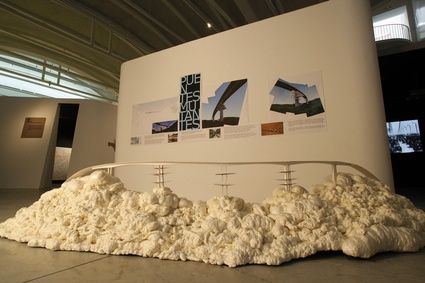 Ángel Borrego-OSS, Puentes Mutantes. Image courtesy Laboral
Ángel Borrego-OSS, Puentes Mutantes. Image courtesy Laboral
The bridges we know today are conceived exclusively for the core purpose for which they exist in the first place: to get from A to B. It didn’t use to be this way. Think of the Ponte Vecchio in Florence and the Rialto in Venice, both were built to host shops and merchants. Or the Pont du Gard which allowed for the passage of people and vehicle but serves also as an aqueduct. Nowadays people use bridge for purposes which did not form part of the original engineering plans.
They use bridges for bungee jumping, committing suicide or watching the landscape, for example. Ángel Borrego from OSS believes that it wouldn’t cost much extra to add one or more uses or options to the design of a bridge. Since a large number of bridges and viaducts cross through spectacular landscapes, they could offer other services besides the passing over of vehicles at high speed. Borrego suggests fitting them with mini-hotels with special features for various animal species (including humans), capsule for people to have a tea, various types of diving boards and games with water, making them places for spectacular views, enabling pedestrian and bicycle crossings between mountainsides that are otherwise inaccessible, etc.
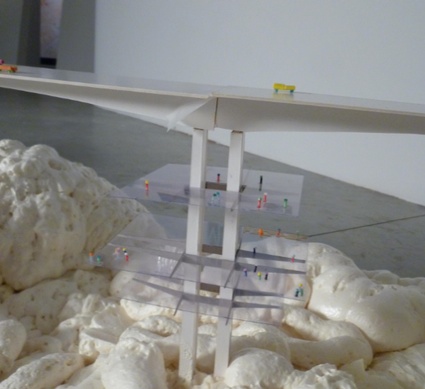 Ángel Borrego-OSS, Puentes Mutantes (detail of a model)
Ángel Borrego-OSS, Puentes Mutantes (detail of a model)
The minimum extra cost of adding these modifications could be offset by their social, environmental, cultural and economic benefits. Similar ‘parasitic’ structures could be applied to bridges that already exist. Mutant Bridges could be the first symbols of a more open, permissive and multiple society.
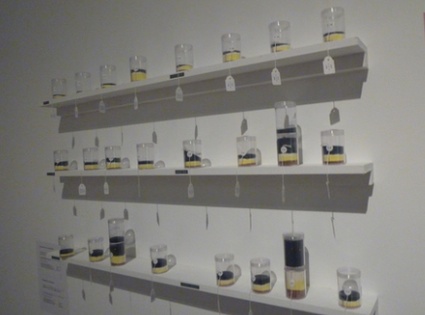
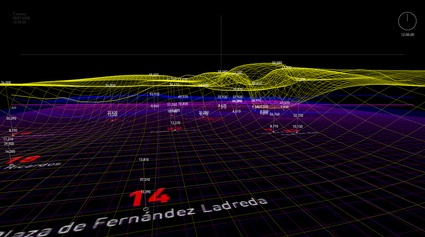 Nerea Calvillo, LABO_In the Air
Nerea Calvillo, LABO_In the Air
Grassroot project LABO_In the Air aims to make visible the microscopic and invisible agents of the air in the city of Madrid (gas, particles, pollen, illnesses, etc) in order to see how they interact with the rest of the urban structure. Nerea Calvillo and the team that surrounded her during a Visualizar workshop at Medialab Prado in Madrid, have developed a web application that represents the levels of geolocalised contamination and their evolution over time using 3D surfaces. When crossing data related with the physical and social weave of the city, the behavioural patterns of different components begin to emerge. Besides, the team developed a series of domestic sensors/ indicators to enable citizens to take part in the production of independent data.
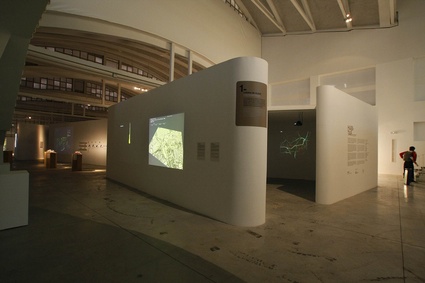 Exhibition view. Image courtesy Laboral
Exhibition view. Image courtesy Laboral
HABITAR was curated by José Luis de Vicente, with conceptual advice from Fabien Girardin.
Photo set over here.
Habitar is on view at Laboral Art and Industrial Creation Centre in Gijón (SP) until November 8, 2010.
